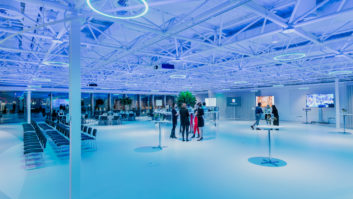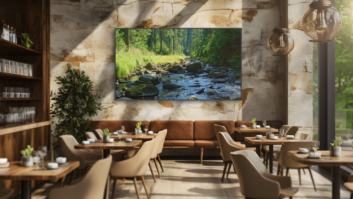The title of a 2022 report by industry trade body AVIXA most likely came as something of a reality check to people in the AV industry who may have thought that progress had been made in the area of gender equality over the last 40 years. Written by AVIXA economic analyst Peter Hansen and the now senior director of business development Joé Lloyd, Pro AV: Are Women Fully Welcome? opened with the unvarnished conclusion that women had “not necessarily found their forever home” in AV. According to data used for the survey, this was due to under-representation, “possible bias” and a lack of advancement.
Hansen and Lloyd pointed out that this came at a time in pro AV when the demand for staff outstripped supply. They additionally found that women were “even more under-represented in the business than non-white workers”, while also facing a major disparity when it came to pay. A study carried out for AVIXA in 2021, a year before the women in AV report, found that women in pro AV at the time earned between 79 and 89 percent of what their male colleagues were paid. Since then there has been some improvement, with a new pay survey published in September of this year showing that the gap has narrowed to between 86 and 94 percent.

Hansen takes the positive view that the latest figures are a sign of “real change”, crediting this partly to the promotion of equality through organisations including Women in Live Music and AVIXA’s own Women’s Council. These initiatives are seen to have highlighted the problems of inequality for women in AV and helped in improving the situation, but some voices in the industry, including Joé Lloyd, do not view the efforts as having improved things enough.
“While the industry continues to make strides in equality, at AVIXA we unfortunately do not see equality in either the percentage of women in the industry, compared to their male counterparts, nor pay,” she says. “With the InfoComm 2024 attendance records showcasing only 14 percent women in attendance, it is a clear indication of the disparity, which does not even begin to counter the lack of diversity within the executive suite and boardroom.”
Another of the leading international AV shows, ISE, has seen a rise in the proportion of female attendees, from 14.2 percent in 2022 to 16.6 percent this year. The event’s PR manager, Rebecca Khelifa-Bonk, has worked in AV for over 20 years but feels it is only now that she, at over the age of 45, is able to exploit her potential. “That is due to the classic division of roles,” she explains. “Women stay at home more often, putting their careers on hold and devote themselves to family and raising children. It will take some time until classic gender roles and biases are completely broken down and women can plan their careers from the start in the same way men have done for centuries.”
Khelifa-Bonk says that she has seen the AV industry become more inclusivs, with an increasing number of women entering both business and technical roles. “The industry’s diverse applications and openness to all genders, age groups, religions, and levels of knowledge make it an attractive field for those seeking a varied and fulfilling career,” she says.
SMALL PROPORTION
Sadie Groom, co-chair of AVIXA Women’s Council UK and chief executive of PR and marketing company Bubble Agency, comments that although women are represented in AV today it is still only a small proportion of the overall workforce.
“From the meetings and shows attended I would say about one quarter of the AV sector is female but it could be less at around 20 percent,” she says. “There are some great women in leadership positions in the vendor and partner businesses but these are rare. I generally find the men in the industry supportive and they do want to see women progress, but sometimes I don’t think they or the HR teams know how to do it, [such as offering] flexible working and dealing with different skill sets.”
Groom agrees that the largest proportion of women in AV work on the business and management side. “This has come from women arriving from the IT sector, where there is a much larger emphasis on diversity and inclusion,” she says.
“I see fewer women in technical areas. Deborah Jones [AV/IT sales manager at the Queen Elizabeth II Centre] says that in technical meetings the ratio is 3:1 men to women. And at ISE this year there was an incident when a visitor came on to a stand and
asked to speak to a man because they had a technical question.
“Why women aren’t coming in on this side of AV could come down to what they are looking at in terms of qualifications, whether they are put in front of technical subjects and are told about the AV sector as an attractive career path. This is where a lot of work needs to be done.”
Groups like the AVIXA Women’s Council and its UK branch (previously Women in AV) have been involved in this work and generally campaigning to level the gender playing field in the industry.

Toni Moss, managing director of systems integrator Strive AV, has worked in the sector for 30 years and was involved with Women in AV, but now questions the necessity for such organisations. “There are more women in AV than ever before, notable at [the recent] Midwich TechExpo24 which appeared to have more women attending than men,” she says. “In order for us to be a more inclusive industry, I believe it’s important to have men in these discussions, as seen in the AVIXA Women’s Council. Why should we alienate anyone?”
Strive AV’s brand manager, Claire Pullen, adds that while the AV market may still not have a perfect gender balance, current methods aimed at achieving equality could be counterproductive. “I don’t believe initiatives focused solely on women are fulfilling their intended purpose,” she explains. “Some of these groups may inadvertently create further segregation between men and women, suggesting that women require a different approach to succeed in AV.”
BUSINESS ISOLATION
AVIXA Women’s Council co-leader Carys Green, who is also account director at Workspace Audio Visual, responds by saying that initiatives to promote women in AV won’t necessarily be suited to every woman in the industry. “But for some people who feel isolated in the business it can help with confidence building,” she says. “And we are getting many men involved as allies. It’s also been the case that the person with the right experience should be hired and not just because they’re a woman. AV is a technology-led industry and because of that it has been male-led, but we want to make sure women who are interested in it have opportunities to join.”
David Daniels, sales director of ITSL Group, also views the AV sector today as being more open to women than in the past, although not every part of it to the same extent.
“The only area that is not welcoming is physical installation,” he comments. “Women don’t go for those roles but there is no chauvinism by any stretch of the imagination. And there are probably more women working in AV than people are aware of,” he says. “I have to admit that our company is very male-oriented, but that’s not by choice. It can just be how things have landed, as when there was a woman salesperson who was perfect for a role but we hadn’t been given the right location for where she was and that didn’t work for us.”

GROWTH STRAINS
From the recruiter’s point of view, Chance Turner, director of talent acquisition at AVI Systems, observes that demand for talented individuals consistently outweighs supply in the industry, which puts strain on a company’s ability to grow and scale.
“More women entering the industry is one strategy to help alleviate this issue,” he says. “I started in AV in 2012 and there has been a change for the positive since then. I think women – and not just women, people of all diverse groups – have seen the growth of AV and recognise the opportunities.”
Turner acknowledges that women have always worked in sales, administration, marketing and business support roles in AV, but says there are also more now in what would once have been considered male positions.
“There has been a big increase in women in leadership,” he says, “and companies are making it more of an initiative to find those individuals. It is still lacking on the technical side, [although] you do see more women entering engineering jobs such as sales engineer and design engineer. But you don’t see as many on the installation side.”
AIMING HIGH
There is clearly still some way to go in correcting gender inequalities across the AV industry, and definitely clear differences in opinion on what, if anything, needs to be done. But, thankfully, it’s also fair to say that significant progress has been made in recent years. As long as AV continues to aim high, even as it continues to fall short, gender inequalities will hopefully become a thing of the past.







